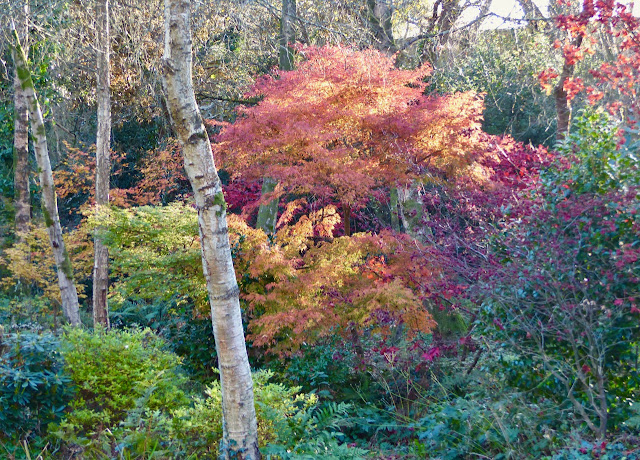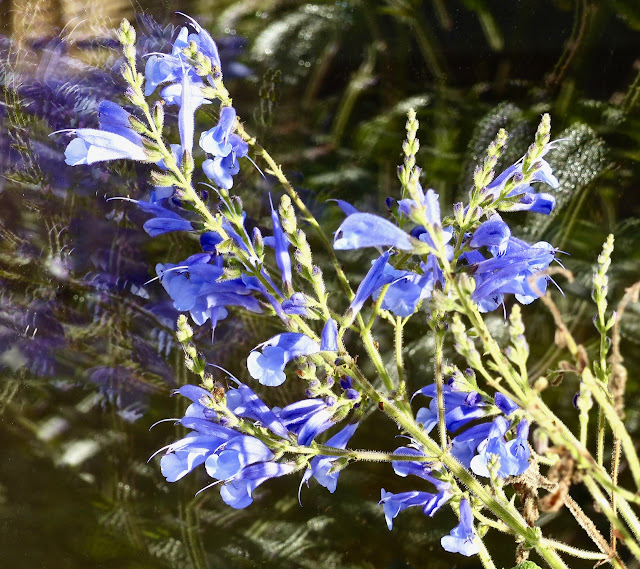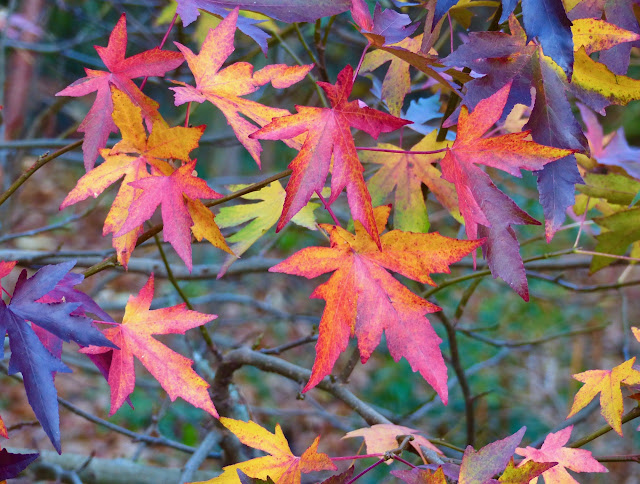The first frosts of winter are biting as I write and the most glorious season of the year is falling slowly to the ground. Thank heaven that the natural cycles of life continue, in spite of man’s best efforts to destroy our planet.
‘COP26’ has just passed and left me and many other caring folk disappointed, even angry, fearing that the reality of all the world’s leaders’ decisions is ‘COP-OUT’! Some good decisions were made but will it result in action? As our amazing Queen eloquently said “The time for words has moved to a time for action”. I pray that at least some of the promises are honoured.
Anyway, I’m not going to bang on about the politicians’ failures now, that can come later because celebrating the beauty that surrounds us in our gardens is a much needed antidote.
Sue and I are very lucky to have our little wildlife garden and I’m sure we are not alone in noticing how colourful this autumn’s trees and shrubs have been.
All the pics that follow were taken on our patch during the last few weeks and illustrate just how delightfully mild the weather has been this November, so we’re still blessed with butterflies, bees and hoverflies visiting our asters, dahlias, salvias and hebe’s.
Being a gardening beginner, I find it fascinating to learn about the origins of our colourful plants, the hebe for instance being a native of New Zealand, South America and even the Falkland Isles.
Still flowering outside at the end of November, even after the frosts the red admirals and peacocks are finding they provide lots of nectar as last minute sustenance before they hibernate in our old sheds and log piles.
Also vital to the late season pollinators are the ever popular dahlias. Natives of the high hillsides of Central America and Mexico [it’s their national flower], there are forty two species and long ago, the Aztecs grew the tubers as food, a crop that only died out after the Spanish Conquest. There were attempts to farm them in Europe but those plans failed, a relief as we can’t admire them if we eat them!
This one is Bishop of Canterbury. We had originally planted that all time favourite, the Bishop of Llandaff but the slugs eat them, so we planted this one in a pot and it’s been blooming wonderful for months, only ceasing to attract carder bees a couple of weeks ago.
The blousier bloomed dahlias are spectacular but the single flowerers like the ‘bishops’ are the ones that provide a banquet for hungry buzzers. They love ‘em!
Regardless of where plants come from, we like planting the garden so it provides food for wildlife, such as our colourful cotoneasters.
When the migrant blackbirds arrive from Europe, they home in on any tasty snacks, though the red berried beauties come from further afield, the mountains of southwestern China and the Himalayas.
Our robins joined the party recently and have almost stripped the plants bare already, so fingers X’d the winter isn’t cold enough to leave them short of food.
Our ripening grapes proved attractive to the many red admirals but once the squadrons of blackbirds arrived, they were scoffed in no time, though not before we had harvested some bunches for our wine. Sue has prepared the brew with added brandy and it’ll be ready for quaffing in six months time, by which time the blackbirds will be singing and when we’ve tasted it, so will we.
Our dahlias have closed for the winter, unlike the sparkling salvias that remain open for business, the cobalt and sapphire jewels so uplifting as the days shorten into winter gloom. This one is called 'Blue Butterflies'.
Flowering long into the autumn, these beauties are vitally important to our carder bees, providing a last supper before they hunker down together, two hundred or more protected from the chill in their dense grass nests. Note to self - don’t ‘tidy' the garden too much, if at all! Red admirals love nettles, so leave them be.
As all passionate gardeners will know, there are hundreds of different salvias, nearly a thousand throughout the old world and Americas, in central and eastern Asia and the Med, even high up in the Andes mountains. [This wind swept red bush isn't a salvia of course but anathrophillum desideratum with a Patagonian Andes background].
First named 'salvia' in Roman times, the meaning is‘to feel healthy, to heal’ and being the largest genus of plants in the sage family, along with rosemary, maybe the Romans knew about the culinary delights and health benefits of the common sage and other herbs in the kitchen. And us humans aren’t alone in eating them, for as already mentioned, many salvias are meccas for pollinators, one of our favourite salvias being ‘Amistad’, still flowering outside at the end of November, even in this Arctic blast.
Apart from salvias and dahlias, I guess the most admired of the autumn ‘show-offs’ are the maples or Japanese Acers, the majority of the 132 species hailing from Asia, with others flourishing in Europe, N.Africa and N.America.
So admired are maples that tourism thrives due to Canada’s fall colours, their national flag incorporating a stylised maple leaf. They are also admired for the sap from some species producing that sweet maple syrup.
Another colourful highlight in our garden are the American Sweet Gums whose fragrant sap provides its name ‘Liquidamber’. Aren’t they gorgeous.
As in Canada, Japan has leaf watching traditions and customs with festivals attracting thousands of admirers from around the world.
There are now so many varieties and cultivars of Acer Palmatum that Sue and I are tempted to add one or two new ones to our woodland garden every year but in the meantime, we simply sit and admire the spectacle that they treat us to every autumn. Good for the soul!
And with the magic of winter and the arrival of geese from far northern lands to look forward to, we have lots to celebrate, even if the problems faced by nature seem depressingly insurmountable.
However, we have the power to help ease the problems of climate change and our gardens are a good place to start. And if all of us plant them to help wildlife, we WILL make a difference. So chin up, spring is on the way!



































No comments:
Post a Comment